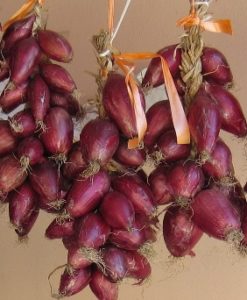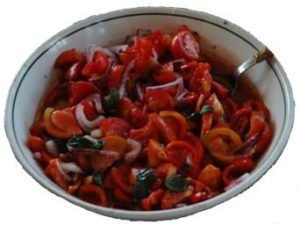The village has vast areas cultivated with vegetables by industrious peasants. The cultivation of particular value in Nocera Terinese is the onion of the quality now known internationally as “Onion of Tropea“.
 It is not uncommon to find peasants, walking the streets of the country, who offer their products. Products that color their baskets of the colors of nature and among which there are certainly plenty of onions with a special taste that are grown here.
It is not uncommon to find peasants, walking the streets of the country, who offer their products. Products that color their baskets of the colors of nature and among which there are certainly plenty of onions with a special taste that are grown here.
We suggest you eat these onions even fresh, perhaps to enrich a salad of those tomatoes also special of the quality called “Belmonte tomatoes“.
 Particularly native to the territory of Capo Vaticano and Ricadi, where many farms grow and market, the famous red Tropea onions that are exported abroad, commonly referred to by the name of the most important center of the area (Tropea), from where they were shipped by ships and trains for centuries, they are now also produced in other centers such as that of Nocera Terinese.
Particularly native to the territory of Capo Vaticano and Ricadi, where many farms grow and market, the famous red Tropea onions that are exported abroad, commonly referred to by the name of the most important center of the area (Tropea), from where they were shipped by ships and trains for centuries, they are now also produced in other centers such as that of Nocera Terinese.
In these areas the bulb has found an ideal microclimate. In fact, the sweetness of this bulb depends, as well as the variety, the mild climate and sandy soils that are located near the sea along the Tyrrhenian coast of Calabria.
In the early 1900s the Tropea onion abandoned the cultivation of small gardens and family gardens to move to considerable extensions in 1929 with the Valle Ruffa aqueduct, which allows irrigation and higher yields and quality improvement.
At the first production organized in the territories of Tropea, Parghelia, Briatico and Zambrone, Ricadi and the promontory of Capo Vaticano, the coastal territory north of the Gulf of S. Eufemia, which can be identified between the municipalities of Gizzeria and Longobards, with particular development between Amantea – Campora San Giovanni and Nocera Terinese.
Today, as then, red onion is present in family gardens as in large areas, in rural landscapes, in food and local dishes and traditional recipes, involving hundreds of small companies engaged throughout the supply chain.
Sowing takes place starting in August, directly in the nursery or in the open field. The transplant is carried out from September to January for the early onion and from January to March for the late onion. And the harvest from April onwards. All cultivation operations are carried out by hand by local farmers.
After harvesting, the women select and weave, with skillful movements of the hands, the red onions separating the small ones from medium and large ones.
The processing techniques are handed down from one generation to the next.
Onions are preserved after being intertwined.
In reality there are three types on the market: the fresh one with the leaves, the red one, obviously the best known; the white spring onion; the onion from Serbian, dry and without leaves.
Characteristic is its elongated shape covered with a thin red skin, while the inside is white and fleshy.
Known for its sweetness, due to a high percentage of sugars (mainly glucose and fructose), rich in potassium and sodium, but with few fats, the Red Onion of Tropea, is quite digestible. The bulb contains a lot of vitamin C, vitamin E, iron, selenium, iodine, zinc and magnesium, has many beneficial effects, one of these is the anti-sclerotic power that brings benefit to the heart and arteries, and prevents the risk of heart attack, is also traditionally used to treat intestinal infections, kidney stones and pertussis, finally used as a natural sedative, useful for reconciling sleep.
The skin is covered with a thin red skin, while the inside is white and fleshy.
Two for a high percentage of sugars (mainly glucose and fructose), rich in potassium and sodium, but with few fats, the Red Onion of Tropea, is quite digestible. The bulb contains a lot of vitamin C, vitamin E, iron, selenium, iodine, zinc and magnesium, has many beneficial effects, one of these is the anti-sclerotic power that brings benefit to the heart and arteries, and prevents the risk of heart attack, is also traditionally used to treat intestinal infections, kidney stones and pertussis, used for natural sedative, useful for reconciling sleep.
Source: Disciplinary of production of the protected geographical indication “CIPOLLA ROSSA DI TROPEA CALABRIA” of the Ministry of Agricultural, Food and Forestry Policies
![]() Disciplinare_di_produzione_Cipolla_di_tropea
Disciplinare_di_produzione_Cipolla_di_tropea
[DISPLAY_ULTIMATE_PLUS]